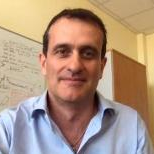Patient-Tailored Biomimetic Scaffold Constructs for Bone Regeneration
A special issue of Applied Sciences (ISSN 2076-3417). This special issue belongs to the section "Materials Science and Engineering".
Deadline for manuscript submissions: closed (31 January 2021) | Viewed by 25942
Special Issue Editors
2. Fondazione Policlinico Universitario Agostino Gemelli IRCCS, 00168 Rome, Italy
Interests: bone biology; osteogenic mechanisms; bone regenerative strategies; orthopedics; craniofacial surgery
Special Issues, Collections and Topics in MDPI journals
Interests: drug design; drug delivery; protein interactions
Special Issues, Collections and Topics in MDPI journals
Interests: cell–material interactions; drug delivery; biological characterization of nano- and micromaterials
Special Issues, Collections and Topics in MDPI journals
Interests: biomaterials; bioceramics; biopolymers; biocomposites; ecosustainable materials; scaffold; spheres; fibers; coatings; sol–gel processes; valorization of agro-food waste extracts and by-products; electrospinning; additive manufacturing; physicochemical characterization; microstructure; thermal and mechanical properties; tissue engineering/regenerative medicine; drug delivery
Special Issues, Collections and Topics in MDPI journals
Special Issue Information
Dear Colleagues,
The present-day health demographic scenario shows an increasingly aging population. Age-related bone frailty represents a critical medical challenge in particular, owing to the physiologic decrease in bone self-healing properties and the heterogeneous co-morbidities that coexist in the elderly. The incidence of fragility fractures in Europe was nearly 3 million in 2017 and is foreseen to increase significantly in the next few decades, creating a pressing need for rapid technological improvement in the field of bone reconstructive/regenerative techniques. Native bone tissue features a complex three-dimensional structure, with multiple levels of complexity, from the molecular, through the nanostructure to the micro- and macroscopic architecture. To achieve an effective restoration of tissue morphology and functionality, new biomimetic systems and bone tissue engineering strategies are emerging, as an alternative to bone grafting and conventional static scaffold compounds, to achieve the dynamic changes needed for the correct balance between mechanical strength and plasticity in the newly formed bone. Implants for tissue engineering strongly depend on (bio)materials, on the manufacturing process, and on the possible implementation of biological structures, including stem cells, growth factors, and derivatives. In this context, the rapid advance in additive manufacturing techniques offers a promising tool, particularly in the vision of a custom-made, patient-oriented approach. However, it is still necessary to better identify and overcome technical and regulatory drawbacks.
This Special Issue aims to address the challenges in the development of new biomimetic systems and technologies in the field of bone regeneration and reconstruction, including new scaffold design and engineering novel biomaterials, innovative scaffold design, advanced (bio)printing and 4D printing techniques, scaffold–cell interactions, drug delivery and scaffold functionalization strategies, imaging techniques for ultrastructural characterization, and valuable state-of-the art meta-analyses, in order to provide a complete and multidisciplinary vision of the faced thematic, from the engineering aspect to the biological and clinical point of view.
Prof. Dr. Wanda Lattanzi
Prof. Dr. Alessandro Arcovito
Prof. Dr. Giuseppina Nocca
Prof. Dr. Ilaria Cacciotti
Guest Editors
Manuscript Submission Information
Manuscripts should be submitted online at www.mdpi.com by registering and logging in to this website. Once you are registered, click here to go to the submission form. Manuscripts can be submitted until the deadline. All submissions that pass pre-check are peer-reviewed. Accepted papers will be published continuously in the journal (as soon as accepted) and will be listed together on the special issue website. Research articles, review articles as well as short communications are invited. For planned papers, a title and short abstract (about 100 words) can be sent to the Editorial Office for announcement on this website.
Submitted manuscripts should not have been published previously, nor be under consideration for publication elsewhere (except conference proceedings papers). All manuscripts are thoroughly refereed through a single-blind peer-review process. A guide for authors and other relevant information for submission of manuscripts is available on the Instructions for Authors page. Applied Sciences is an international peer-reviewed open access semimonthly journal published by MDPI.
Please visit the Instructions for Authors page before submitting a manuscript. The Article Processing Charge (APC) for publication in this open access journal is 2400 CHF (Swiss Francs). Submitted papers should be well formatted and use good English. Authors may use MDPI's English editing service prior to publication or during author revisions.
Keywords
- osteoconduction
- osteoinduction
- biomimetic scaffolds
- personalized medicine
- additive manufacturing
- biotechnology
- nanotechnology
- regenerative medicine








